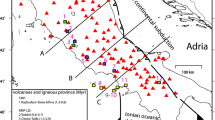Abstract
—The Italian peninsula shows high complexity of the mantle-crust system and of the Plio-Quaternary magmatism. The lithospheric thickness has remarkable lateral variations from about 110 km to about 30 km. Intermediate and deep-focus earthquakes indicate the presence of a lithospheric slab under the Aeolian-Calabrian area and at the southern end of Campania. Much less extensive intermediate-depth seismicity characterizes the Roman-Tuscany region, where the existence of a relic slab has been hypothesized. The deep seismicity in the southern Tyrrhenian Sea is associated with active calcalkaline to shoshonitic volcanism in the Aeolian arc. Alkaline potassic volcanism occurs in central Italy, and potassic lamproitic magmatism coexists with crustal anatectic and various types of hybrid rocks in the Tuscany area.¶The parallelism between changing magmatism and variation of the structure of the crust-mantle system makes central-southern Italy a key place where petrological and geophysical data can be used to work out an integrated model of the structure and composition of the upper mantle. Beneath Tuscany the upper mantle has been affected by intensive subduction-related metasomatism. This caused the formation of phlogopite-rich veins that cut through residual spinel-harzburgite and dunite. These veins, possibly partially molten, may explain the unusually soft mechanical properties that are detected just below the Moho. In the Roman Province, the upper mantle is formed by a relatively thin lid (the mantle part of the lithosphere) and by metasomatic fertile peridotite, probably connected with the upraise of an asthenospheric mantle wedge above the Apennines subduction zone. Geochemical data indicate that metasomatism, though still related to subduction, had different characteristics and age than in Tuscany. In the eastern sector of the Aeolian arc and in the Neapolitan area, the upper mantle appears to be distinct from the Roman and Tuscany areas and is probably formed by fertile peridotite contaminated by the presently active subduction of the Ionian Sea floor.¶The overall picture is that of a mosaic of various mantle domains that have undergone different evolutionary history in terms of both metasomatism and pre-metasomatic events. The coexistence side by side of these sectors is a key factor that has to be considered by models of the geodynamic evolution of the Central Mediterranean area.
Similar content being viewed by others
Author information
Authors and Affiliations
Additional information
Received October 17, 1998, accepted March 6, 1999
Rights and permissions
About this article
Cite this article
Peccerillo, A., Panza, G. Upper Mantle Domains beneath Central-Southern Italy: Petrological, Geochemical and Geophysical Constraints. Pure appl. geophys. 156, 421–443 (1999). https://doi.org/10.1007/s000240050306
Issue Date:
DOI: https://doi.org/10.1007/s000240050306




